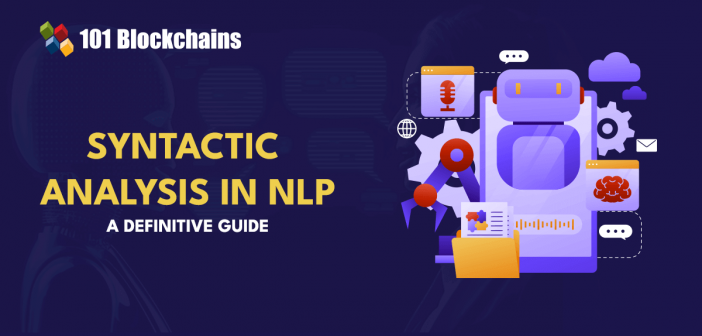Learn how blockchain truly works, master key definitions, and uncover what makes smart contracts so "smart." Dive into the fundamentals, gain valuable insights, and start your blockchain journey today!

- AI & ChatGPT
Georgia Weston
- on March 04, 2024
What Is Syntactic Analysis In NLP?
When it comes to Natural Language Processing, generative text is one of the most important use cases. Generative text involves making predictions of the words that will follow to form a sentence. In layman’s language generative text helps in predicting which word will be written after another word in a sentence. In the technology-driven era, you come across generative text almost everywhere, such as chatbots and word or sentence auto-corrections. Moreover, you may also come across them while performing grammar checks. Undoubtedly, today, generative text has become part and parcel of one’s daily life. Read on to find the answer to – What Is Syntactic Analysis NLP?
Syntactic analysis basically refers to the process of examining natural language by applying the rules of formal grammar. By using grammatical rules for categories and groups of words, it is possible to allocate semantic structure to texts. However, you must bear in mind that grammar rules are not applicable to single words. In generative text, syntactic analysis helps in analyzing words to check for grammar and show the association. If you want to master Natural Language Processing, you must learn Syntactic Analysis NLP.
Unlock your potential in Artificial Intelligence with the Certified AI Professional (CAIP)™ Certification. Elevate your career with expert-led training and gain the skills needed to thrive in today’s AI-driven world.
Fundamentals of Syntactic Analysis
When it comes to Natural Language Processing, syntax plays a cardinal role. This is because it serves as a roadmap for computer systems to comprehend as well as generate human language. Syntactic Analysis in NLP encompasses fragmenting sentences into their grammatical elements.
For example, sentences may be broken down into their grammar components, such as verbs, nouns, and adjectives. Thus, it enables machines to understand the structure as well as the meaning of the texts. You can familiarize yourself with the basics of the concept with the help of the Syntactic Analysis NLP guide.
The syntactic analysis, which is also known as parsing, is responsible for assigning a semantic structure to a given text. The assigning of a logical structure is possible by applying the rules of formal grammar in the context of natural language.
You can refer to Syntactic Analysis NLP examples to improve your clarity on the subject. Here is a simple example for your understanding! The sentence ‘Class go to a girl’ fails to make any sense. It does not have any logical meaning. Moreover, the grammatical structure of the sentence is also not accurate. In this scenario, syntactic analysis will tell us that the particular sentence has no rational or logical meaning. Similarly, it can also tell whether the grammatical structure of a sentence is right or wrong.
Excited to learn the fundamentals of AI applications in business? Enroll now in the AI For Business Course
Purpose of Syntactic Analysis
The fundamental purpose of syntactic analysis is to derive meaning from a text. In the analysis, checks are in place so that texts which are not meaningful or which do not make sense can be rejected. By analyzing a string of symbols by using formal grammar as the guide, Syntactic Analysis In NLP carries out its function.
Syntactic analysis aids in understanding the structure relating to the input text. The analysis is done at an in-depth level starting from the basic symbols to all the way to an entire sentence. This technique enables it to determine whether a text has any logical meaning or not. The concept is of critical importance since it enables machines to understand human language. It plays an instrumental role in bridging the gap between humans and systems.
Identify new ways to leverage the full potential of generative AI in business use cases and become an expert in generative AI technologies with Generative AI Skill Path
Diverse types of Syntactic Structures
Before diving further into the realm of Syntactic Analysis In NLP, you must understand different types of syntactic structures. Syntactic structures consist of a number of elements, such as phrases, clauses, constituency relations, and dependency relations.
-
Phrases in syntactic structures
Phrases refer to a group of words that operate together as a single component within a sentence. Common terms encompass verb phrases as well as noun phrases.
-
Clauses in syntactic structures
Clauses consist of a subject along with a predicate. Hence, clauses are larger or wider units that are used in language. Clauses may be independent, also known as main clauses, or dependent clauses, also known as subordinate clauses.
-
Constituency relations in syntactic structures
Constituency grammar is responsible for breaking sentences into constituents like verb and noun phrases. The purpose of the breakdown is to capture the constituents that shed light on the syntax structure of sentences.
-
Dependency relations in syntactic structures
In the case of dependency grammar, there exists a link between the words of sentences. The link is the dependency relation, which reveals how words in sentences depend on one another. The role of dependency relations is of high relevance in syntactic analysis. This is because they help in capturing the syntactic associations between words.
Want to understand the importance of ethics in AI, ethical frameworks, principles, and challenges? Enroll now in the Ethics Of Artificial Intelligence (AI) Course
Key Syntactic Analysis Approaches
The Syntactic Analysis In NLP makes use of diverse approaches for performing the dissection of grammar structure in language. You need to familiarize yourself with these approaches to strengthen your grip on syntactic analysis. The syntactic analysis approaches present a foundation for the comprehension of how words and phrases in sentences are linked with one another. Some of the chief syntactic analysis approaches include:
-
Rule Based Approaches
Under this approach, context-free grammar is a conventional method. It acts as a useful method in the syntactic analysis domain. It involves a series of rules that capture how the combination of varying components of a sentence takes place. The context-free grammar rule assists in generating parse trees representing a sentence’s syntactic structure.
Dependency grammar is another approach that focuses on the associations that exist between the words of sentences. A unique feature is that instead of creating hierarchical structures, it uses direct links. These links between words showcase which words rely on or depend on others in a sentence. This approach is useful in the case of languages that have a relatively free word order.
-
Statistical Approaches
Under the statistical approaches, Probabilistic Context-Free Grammar (PCFG) is a common method. PCFG basically uses context-free grammar. This is done by assigning probabilities to every production rule. The probabilities are responsible for reflecting the likelihood for a specific rule to be applicable in specific scenarios. This method is common when it comes to statistical parsing. It helps in finding a sentence’s syntax structure, which has the highest likelihood.
Transition-based parsing is another method under the statistical approaches category. It involves the deployment of machine learning techniques for incrementally creating a parse tree. This is done by making decisions at each and every step. In this approach, the use of a series of activities is essential for constructing the ultimate parse tree. Transition-based parsing is highly effective and valuable when it comes to real-time applications.
-
Neural Network-Based Approaches
The common neural network-based approaches in syntactic analysis involve recurrent neural networks (RNNs), convolutional neural networks (CNNs), and transformer models. Each of these methods has different attributes that you must familiarize yourself with before knowing their application. The recurrent neural networks process sequences or series of words.
Moreover, they maintain a hidden state which is responsible for capturing contextual information. A specific syntactic analysis task where RNN has high relevance is part-of-speech tagging. However, a key limitation of RNN is the sequential processing attribute, which limits its capabilities. Moreover, recurrent neural networks struggle when it comes to long-range dependencies.
Convolutional neural networks are able to capture local patterns that may exist in the input. Due to this characteristic, CNN is suitable for the purpose of extracting syntactic associations between closely placed words. For performing dependency parching, the CNN method is applicable.
The common transformer models that have been revolutionizing Natural Language Processing are GPT and BERT. You must already be familiar with these elements and how they are transforming the role of NLP for one and all. These models are capable of capturing local as well as global syntactic information. Due to their robust capabilities, they are seen as state-of-the-art tools of the current era. Some of the syntactic analysis tasks for which these models are ideal include dependency parsing and constituency parsing.
Now that you have a better understanding of key syntactic analysis approaches, you know their relevance. However, you must keep in mind that each approach has its unique strengths as well as limitations. So, you need to make the choice of the approach wisely by taking into consideration the task and the capabilities of the approaches.
Want to learn about ChatGPT and other AI use cases? Enroll now in the ChatGPT Fundamentals Course
Parsing Algorithms
In syntactic analysis, the term parsing refers to the fundamental process of breaking down a sentence. By breaking the sentence into smaller fragments, it is possible to view their grammar components. Furthermore, it is possible to represent them in the form of a parse tree or a dependency graph. Over the years, a diverse range of parsing algorithms have come into existence for performing the specific task. In syntactic analysis, some of the common parsing algorithms are top-down parsing, bottom-up parsing, chart parsing, and shift-reduce parsing.
-
Top-down parsing
Top-down parsing is also known as recursive descent parsing. It begins with the highest-level syntactic structure. Then, the structure is broken down into tinier constituents in a recursive manner. This parsing method initiates from the top-level grammar rule, and as it moves further, the lower-level rules are applicable. In case a rule is not applicable, then the parser retracts and considers different possibilities. The backtracking or retracting feature is the main limitation of top-down parsing.
-
Bottom-up parsing
Just as the name suggests, bottom-up parsing is the opposite of the top-down parsing method. In bottom-up parsing, the parsing begins with single or individual words. The construction of the parse tree is possible through the bottom-up approach. In other words, the tress formation takes place by combining words in a successive manner to form more significant elements. A common example of the bottom-up parsing mechanism is shift-reducing parsing. In this method, progress is made by shifting words to a stack from the input. When the rule has been satisfied, they are reduced.
-
Chart parsing
Chart parsing is a dynamic method that is suitable for ambiguous or unclear grammar. It is capable of creating a chart data structure for storing and combining partial parse trees in an effective manner. In chart parsing, the application of the Cocke-Younger-Kasami (CYK) or Earley parser algorithm is common for context-free grammars.
One of the main highlights of chart phasing is that they are capable of handling ambiguity. Importantly, they are able to give a diverse range of parses for a single sentence. As a result, chart parsing is of immense value when it comes to natural languages which have complex syntax structures.
-
Shift-reduce parsing
The application of shift-reduce parsing is common in the case of dependency parsing with the objective of forming a dependency tree. A unique feature of shift-reduce parsing is that the parser maintains a series of actions along with a stack of words. The grammar rule serves as the ultimate guide on the basis of which the shifting of words takes place. It is a highly efficient method that is capable of handling non-projective syntax structures. Although other parsing may struggle to deal with them, the shift-reduce parsing algorithm may be able to effortlessly work with non-projective syntax structures.
In the context of syntactic analysis, the relevance of parsing algorithms is high. These algorithms basically enable NLP to make sense of the structure of different sentences. Additionally, they also aid in extracting grammar information and recognizing relationships between words.
Develop expert-level skills in prompt engineering with the Prompt Engineer Career Path
Conclusion
In NLP, the role of syntactic analysis is indispensable. It acts as the ultimate medium that helps to understand the logical meaning of sentences or certain parts of sentences. Without performing syntactic analysis, machines might fail to understand human language. The application of formal grammar rules in the Natural Language Processing context makes the analysis possible. In the Syntactic Analysis NLP guide, you have come across diverse concepts such as syntactic structures and syntactic analysis approaches. A solid and comprehensive understanding of syntactic analysis is instrumental in applying it effectively in the practical setting.





